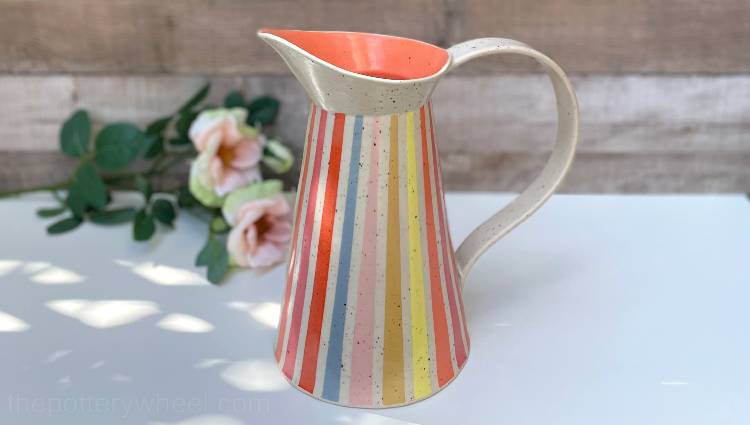Your cart is currently empty!
Low Fire Vs High Fire Clay – Which Clay is Right for You?
Published:
Last Updated:
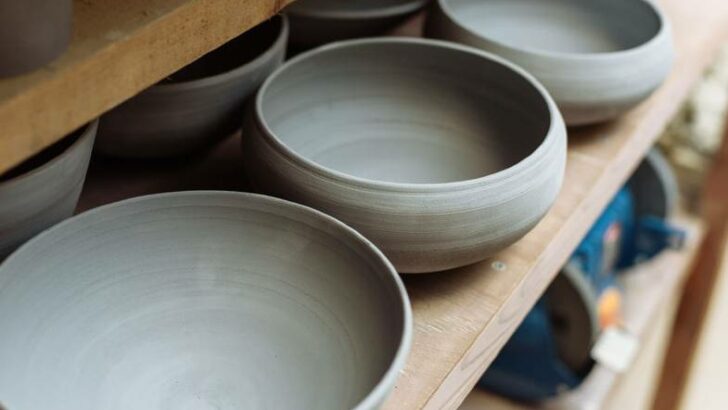
Affiliate Disclaimer
As an affiliate, we may earn a commission from qualifying purchases. We get commissions for purchases made through links on this website from Amazon and other third parties.
There are lots of different types of clay for pottery. One of the ways that pottery clay is categorized is the temperature it should be fired at. Low fire is best fired at low temperatures. And high fire clay is best fired in the high-temperature range. But which will suit you best? This article is all about low fire vs high fire clay. I will look at the pros and cons of low and high fire clay, and some other clays in between.
Low fire clay fires between 1940-2109F. It’s easy and economical to fire. However, it’s still porous. High fire clay fires around 2381F. It’s strong and waterproof. However, it’s best fired in a gas kiln, which is less convenient. Mid fire clay fires between 2157-2232F, it’s strong, waterproof, and easily fired in an electric kiln.
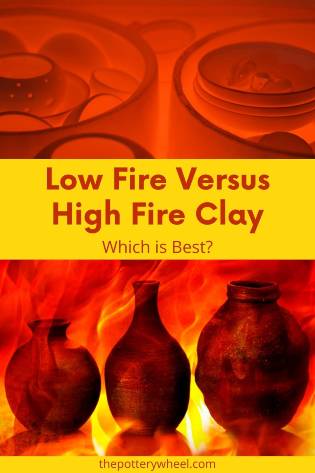
Low Fire Vs High Fire Clay – What are the Differences?
People often talk about low and high fire clay. However, there are actually 3 broad temperature firing ranges. So, the question is not just one of low fire vs high fire clay. Rather, it’s a question of low, mid, or high fire clay and which one suits you best.
Let’s take a look at the difference between low, mid, and high fire clay. First, here is an overview of the actual firing temperature ranges in question. And the corresponding cone rating.
| Clay | Temp (F) | Temp (C) | Cone |
| Low Fire | 1852-2109 | 1011-1154 | 06-1 |
| Mid Fire | 2158-2266 | 1181-1241 | 4-6 |
| High Fire | 2316-2377 | 1269-1303 | 8-10 |
A Brief Overview of Cones and What They Mean
Before going on to look at what these differences in temperature mean, I wanted to say a bit about ‘cones’. If you are new to pottery, you may have heard people talking about cones and wondered what they are.
The Orton Cone system is a way of measuring how much heat and time has been used during a kiln firing.
Clay is said to have matured during firing when it has reached its maximum strength and optimal density. I say ‘optimal’ density because more density does not always mean more strength. At some point during ‘densification’, if the clay becomes denser, it also becomes more brittle.
To mature, clay needs a combination of heat and time in the kiln. The combination of heat and time is called ‘heatwork’. It refers to the amount of energy that has gone into firing a piece of pottery. Not just the temperature reached.
Cones are small pieces of ceramic that stand in the kiln when it’s being fired. The cones bend when the pottery has had a particular amount of heatwork. And cones are graded on a scale according to how much heatwork it will take to make them bend.
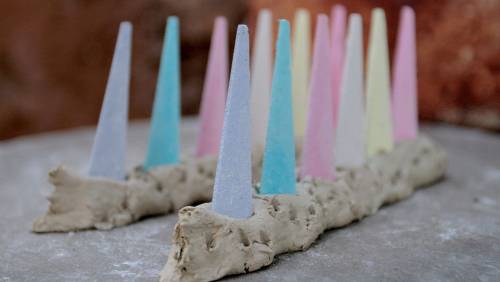
Cones range from cone 022 at very low temperatures, to cone 10 at the higher end of the spectrum. For more information about pyrometric cones, check out this article.
Most electric kilns now have digital temperature controllers that determine the amount heatwork used. However, the cone system is still used to indicate the point at which clays and glazes mature.
What’s more, not all kilns have digital control panels. Some kilns, for example, kilns that use kiln sitters and gas kilns need more manual operation. Potter’s using these kilns still put cones in the kiln to gauge if their ceramics have had sufficient heatwork.
Low Fire Clay
Low fire clay reaches maturity when it is fired, between 1940 -2109F (1060-1154C). On the cone system, this is between cone 04 and 1. These are often referred to as ‘earthenware temperatures’ because earthenware is the term used for low fire clay.
As stated above, a clay is mature when it has become as strong as it can be. The strength of a fired clay depends in part on how dense it becomes when it’s fired. If clay is over-fired, that is, fired at too high a temperature, it becomes too dense and will be brittle.
The strength of fired clay comes from two processes that occur during firing. These are sintering and vitrification.
Sintering occurs when the surfaces of the clay particles next to one another bond together. The clay particles also move closer to one another, so the clay becomes denser. Once clay is sintered, it changes from clay to ceramic.
Vitrification occurs when materials in the clay start to form molten glass. This liquid glass fills up the gaps between the clay particles. And when the clay cools the glass solidifies, and the clay is less porous. Low porosity is one factor that contributes to ceramic strength.
Low fire clay does not vitrify because it doesn’t contain enough of the glass-forming materials required for vitrification.
However, low fire earthenware clay does undergo the process of sintering. As such, low fire clay becomes sintered ceramic, but it is still porous. This is because it does not undergo the glass-forming phase when it is fired.
Low Fire Clay – The Pros
- Low fire clay can easily be fired in a smaller electric hobby kiln. Smaller hobby kilns can normally be plugged straight into a standard electricity supply.
Once you have got the hang of the digital control panel, they are easy to program. It’s not a good idea leave a like unattended. However, once the kiln is programmed you can leave it to do its thing. - Because they reach maturity at lower temperatures, low fire clays require less energy when fired. So, an earthenware firing schedule is cheaper to run.
- Low fire earthenware glazes have a broad range of bright colors. These are often primary colors that keep their brightness as they are being fired.
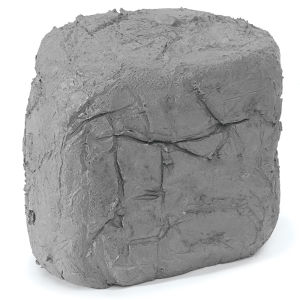
Activa Blackjack Low Fire Clay – View at Blick
- They are also readily available to buy in smaller pint-sized quantities and can be painted on easily.
Low Fire Clay – The Cons
- Low fire earthenware clay is still porous and will absorb water. Earthenware clay can be made waterproof by being glazed. The glaze forms a glassy layer across the surface and seals the porous clay body.
However, to make earthenware clay completely waterproof you need to glaze the bottom of the piece too. If the base of a low fired piece of pottery is unglazed it will let water in when it is washed. - If pottery isn’t vitrified, then any small imperfections in the glaze surface will let water in too. A small imperfection might be a little pinhole or some crazing in the glaze surface. If water gets into the ceramic body, this will over time weaken the pottery. It can also harbor bacteria.
- Non-vitrified low fire clay is not especially strong and chips easily. As a result, low fire clay is not ideal for functional wear. Continual washing and daily knocks and bumps endured by mugs and plates are usually too much for low fire clay.
Nevertheless, if it’s glazed well, low fire clay can be used for items like vases. These are water holding, but providing the glaze creates a good seal, earthenware clay can be suitable.
Mid Fire Clay
Mid fire clay reaches maturity when it is fired, between 2157 – 2232F (1186-1222C). On the cone system, this is between cone 4 and 6.
Although some porcelain clay is fired at mid fire temperatures, mostly clay fired in this range is stoneware. For this reason, the mid fire range is sometimes called ‘stoneware temperatures’.
Stoneware clay is often categorized as either mid fire or high fire. Mid fire stoneware is usually glaze fired at cone 6. So, you will also hear potters talking about using cone 6 clay.
However, some stoneware clays are sold as being suitable for firing between cone 6 and 10.
Unlike low fire clay, mid fire clay does vitrify when it reaches maturity in the kiln. Mid fire clay goes through the sintering process. Then once it reaches a high enough temperature, the glass-forming materials in the clay, mostly silica, start to melt.
Vitrification is a process. So, a piece of ceramic can be more or less vitrified, depending on whether it’s had enough heatwork. The more vitrified the clay becomes, the less porous it will be once it has cooled.
Ideally, functional pottery needs to have 2% porosity or less. This means that only 2% of the ceramic body is made up of pores. The rest is made up of solid matter. Many cone 6 stoneware clays can achieve this target of 2% porosity if they are fired to the right temperature.
Mid Fire Clay – The Pros
- Because mid fire stoneware is vitrified when it’s mature, it has very low porosity and makes very good functional ware. This means that it’s good for items such as mugs, dinnerware, and cooking vessels such as casserole dishes.
The reason it’s good for functional ware is that mature stoneware is strong. It can endure day-to-day knocks and bumps without too much worry that it will chip and break. - Also, because it doesn’t absorb water, it can be usually used in the microwave, oven, or freezer. If ceramics have absorbed a lot of water, then big changes in temperature will cause the water to expand. This puts the pottery under a lot of stress and weakens them.
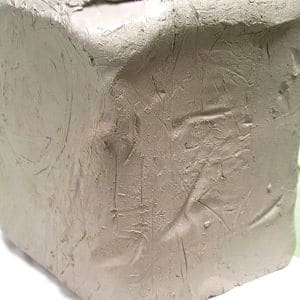
Warm Buff Stoneware Clay – View on Blick
- It can also make them dangerous to use. For example, ceramics that have absorbed water and are then used in the microwave can get very hot spots. Likewise, waterlogged ceramics that are put in the freezer can break as the water expands and freezes.
So, if you are hoping to make functional dinnerware and you are asking about low fire vs high fire clay, high or mid fire clay is the best choice. - From a practical point of view, mid fire stoneware is easy to use whether you are hand-building or throwing. This is especially true if the stoneware has some fine grog in it to give it some internal strength and ‘buildability’.
- Most electric kilns will fire up to cone 6. So mid fire stoneware has the added convenience of being suitable for an electric kiln.
Mid Fire Clay – The Cons
- Some of the pigments used in commercially produced glazes can fade at the mid fire temperature. Glazes in the mid fire range are therefore sometimes not quite as bright as in the low fire range.
This isn’t always seen as a drawback. If the bright, primary colors of the low fire range, aren’t to your taste, then this isn’t an issue.
High Fire Clay
High fire clay reaches maturity when it is fired up to cone 10. This is 2381F (or 1305C)
Some stoneware is high fire and most porcelain is fired at this temperature.
Like mid fire clay, high fire clay is vitrified and non-porous if it has been fired to the right temperature. When considering low fire vs high fire clay, if you want non-porous ware, then you should choose mid or high fire clay.
A lot of electric kilns fire up to high fire temperatures. However, firing to cone 10 in an electric kiln is very tough on the kiln elements. And you will find you have to replace these more often if you are firing to higher temperatures. When considering low fire vs high fire clay, wear and tear on electric kilns from high temperatures may be a factor.
High fire temperatures are more often associated with gas firing and wood firing. Whilst electric kilns are used for oxidation firing. Gas and wood firing can be used to create a reduction atmosphere in the kiln.
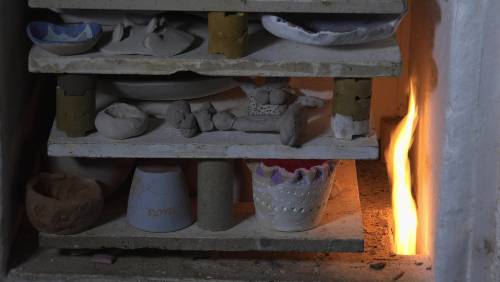
Simply put, an oxidation atmosphere in a kiln contains oxygen. Whereas a reduction atmosphere contains a reduced amount of oxygen. The amount of oxygen present in a kiln will affect what glazes look like.
High Fire Clay – The Pros
- High fire clay can be fired in a reduction atmosphere. Oxidation atmospheres, tend to produce brighter glazes with more primary colors.
- By contrast, reduction atmospheres produce more organic, rustic, or earthy tones. Some potters find that a reduction atmosphere produces a depth and richness in glazes that is lacking from oxidation.

Amaco White Stoneware Clay – View on Blick
- For more information about the difference between oxidation and reduction, check out this article.
- Porcelain and high fire stoneware, when fired to the right temperature produce strong, durable ceramics. This is good for functional ware.
High Fire Clay – The Cons
- Firing to high fire temperatures in an electric kiln is tough on the kiln. However, firing using a gas or wood firing kiln is more labor-intensive.
A lot of electric kilns have the convenience of being programmable. By contrast, a gas kiln needs more attention as it fires. Some potters enjoy the process of gas firing and like the hands-on experience. Others prefer the convenience of an electric kiln. - There are commercially produced glazes that will give you the “reduction look” from mid-fire temperatures. This is worth considering when weighing up the advantages of low fire vs high fire clay. Glazes with a ‘reduction look’ are normally available for mid fire and high fire clays. But not for low fire clay.
- Fuel-burning kilns like gas or wood produce more fumes and exhausts that need venting.
- It is often said that high fire clay is stronger when it’s mature than mid fire clay. This is because it is thought to achieve a higher degree of vitrification.
However, if mid fire cone 6 clay is fired to the right temperature, it can achieve less than 2% porosity. This means that it will be as strong as a comparable high fire clay.
What is more important is whether the clay is fired to the right temperature. If a mid fire clay is fired well, it can be as strong and dense as a high fire clay. - There are fewer commercially available high fire glazes available. As a result, you’re more likely to have to make your own glaze to suit your high fire clay body.
Final Thoughts
Choosing the right clay is important, however, it’s not as simple as low fire v’s high fire clay. Selecting a mid fire clay is also an option, and in my opinion, it’s often the best option. Mid fire clay gives you the best of both worlds. It is strong and waterproof but has the convenience of being easily fired in an electric kiln. Perhaps you don’t own a kiln and you are relying on a community center to fire your work. If that’s the case, it’s a good idea to find out what temperature they fire at. And then choose a clay body accordingly.

